TonEBP inhibits ciliogenesis by controlling aurora kinase A and regulating centriolar satellite integrity
- PMID: 38961488
- PMCID: PMC11221002
- DOI: 10.1186/s12964-024-01721-8
TonEBP inhibits ciliogenesis by controlling aurora kinase A and regulating centriolar satellite integrity
Abstract
Background: Primary cilia on the surface of eukaryotic cells serve as sensory antennas for the reception and transmission in various cell signaling pathways. They are dynamic organelles that rapidly form during differentiation and cell cycle exit. Defects in these organelles cause a group of wide-ranging disorders called ciliopathies. Tonicity-responsive enhancer-binding protein (TonEBP) is a pleiotropic stress protein that mediates various physiological and pathological cellular responses. TonEBP is well-known for its role in adaptation to a hypertonic environment, to which primary cilia have been reported to contribute. Furthermore, TonEBP is involved in a wide variety of other signaling pathways, such as Sonic Hedgehog and WNT signaling, that promote primary ciliogenesis, suggesting a possible regulatory role. However, the functional relationship between TonEBP and primary ciliary formation remains unclear.
Methods: TonEBP siRNAs and TonEBP-mCherry plasmids were used to examine their effects on cell ciliation rates, assembly and disassembly processes, and regulators. Serum starvation was used as a condition to induce ciliogenesis.
Results: We identified a novel pericentriolar localization for TonEBP. The results showed that TonEBP depletion facilitates the formation of primary cilia, whereas its overexpression results in fewer ciliated cells. Moreover, TonEBP controlled the expression and activity of aurora kinase A, a major negative regulator of ciliogenesis. Additionally, TonEBP overexpression inhibited the loss of CP110 from the mother centrioles during the early stages of primary cilia assembly. Finally, TonEBP regulated the localization of PCM1 and AZI1, which are necessary for primary cilia formation.
Conclusions: This study proposes a novel role for TonEBP as a pericentriolar protein that regulates the integrity of centriolar satellite components. This regulation has shown to have a negative effect on ciliogenesis. Investigations into cilium assembly and disassembly processes suggest that TonEBP acts upstream of the aurora kinase A - histone deacetylase 6 signaling pathway and affects basal body formation to control ciliogenesis. Taken together, our data proposes previously uncharacterized regulation of primary cilia assembly by TonEBP.
Keywords: Aurora kinase A; Centriolar satellite; Ciliogenesis; TonEBP; Γ-tubulin.
© 2024. The Author(s).
Conflict of interest statement
The authors declare no competing interests.
Figures







Similar articles
-
CCP5 and CCP6 retain CP110 and negatively regulate ciliogenesis.BMC Biol. 2023 May 24;21(1):124. doi: 10.1186/s12915-023-01622-1. BMC Biol. 2023. PMID: 37226238 Free PMC article.
-
A subset of evolutionarily conserved centriolar satellite core components is crucial for sperm flagellum biogenesis.Theranostics. 2025 Jun 12;15(14):7025-7044. doi: 10.7150/thno.117118. eCollection 2025. Theranostics. 2025. PMID: 40585997 Free PMC article.
-
Short-Term Memory Impairment.2024 Jun 8. In: StatPearls [Internet]. Treasure Island (FL): StatPearls Publishing; 2025 Jan–. 2024 Jun 8. In: StatPearls [Internet]. Treasure Island (FL): StatPearls Publishing; 2025 Jan–. PMID: 31424720 Free Books & Documents.
-
Signs and symptoms to determine if a patient presenting in primary care or hospital outpatient settings has COVID-19.Cochrane Database Syst Rev. 2022 May 20;5(5):CD013665. doi: 10.1002/14651858.CD013665.pub3. Cochrane Database Syst Rev. 2022. PMID: 35593186 Free PMC article.
-
Management of urinary stones by experts in stone disease (ESD 2025).Arch Ital Urol Androl. 2025 Jun 30;97(2):14085. doi: 10.4081/aiua.2025.14085. Epub 2025 Jun 30. Arch Ital Urol Androl. 2025. PMID: 40583613 Review.
Cited by
-
Histone Deacetylase 6 (HDAC6) in Ciliopathies: Emerging Insights and Therapeutic Implications.Adv Sci (Weinh). 2025 Jun;12(21):e2412921. doi: 10.1002/advs.202412921. Epub 2025 Apr 1. Adv Sci (Weinh). 2025. PMID: 40167251 Free PMC article. Review.
References
-
- Prosser SL, Pelletier L. Centriolar satellite biogenesis and function in vertebrate cells. J Cell Sci. 2020;133(1):jcs239566. 10.1242/jcs.239566. - PubMed
Publication types
MeSH terms
Substances
Grants and funding
LinkOut - more resources
Full Text Sources
Research Materials
Miscellaneous

